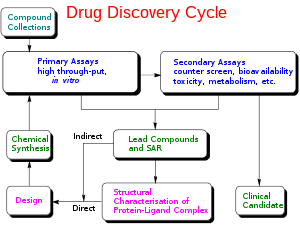Preclinical development
This article needs more primary sources. (June 2020) |  |
In drug development, preclinical development (also termed preclinical studies or nonclinical studies) is a stage of research that begins before clinical trials (testing in humans) and during which important feasibility, iterative testing and drug safety data are collected, typically in laboratory animals.
The main goals of preclinical studies are to determine a starting, safe dose for first-in-human study and assess potential toxicity of the product, which typically include new medical devices, prescription drugs, and diagnostics.
Companies use stylized statistics to illustrate the risks in preclinical research, such as that on average, only one in every 5,000 compounds that enters drug discovery to the stage of preclinical development becomes an approved drug.[1][2]
Types of preclinical research
Each class of product may undergo different types of preclinical research. For instance, drugs may undergo
Typically, both
Animal testing
The information collected from these studies is vital so that safe human testing can begin. Typically, in drug development studies animal testing involves two species. The most commonly used models are murine and canine, although primate and porcine are also used.
Choice of species
The choice of species is based on which will give the best correlation to human trials. Differences in the
Medical device studies also use this basic premise. Most studies are performed in larger species such as dogs, pigs and sheep which allow for testing in a similar sized model as that of a human. In addition, some species are used for similarity in specific organs or organ system physiology (swine for dermatological and coronary stent studies; goats for mammary implant studies; dogs for
Importantly, the regulatory guidelines of FDA, EMA, and other similar international and regional authorities usually require safety testing in at least two mammalian species, including one non-rodent species, prior to human trials authorization.[3]
Ethical issues
Animal testing in the research-based pharmaceutical industry has been reduced in recent years both for ethical and cost reasons. However, most research will still involve animal based testing for the need of similarity in anatomy and physiology that is required for diverse product development.
No observable effect levels
Based on preclinical trials, no-observed-adverse-effect levels (NOAELs) on drugs are established, which are used to determine initial phase 1 clinical trial dosage levels on a mass API per mass patient basis. Generally a 1/100 uncertainty factor or "safety margin" is included to account for interspecies (1/10) and inter-individual (1/10) differences.
See also
References
- New York Times.
On average, only one in every 5,000 compounds that drug companies discover and put through preclinical testing becomes an approved drug. Of the drugs started in clinical trials on humans, only 10 percent secure F.D.A. approval. ...
- ^ "Drug Approvals - From Invention to Market...12 Years!". MedicineNet. Retrieved 2021-04-21.
- PMID 26281720.

